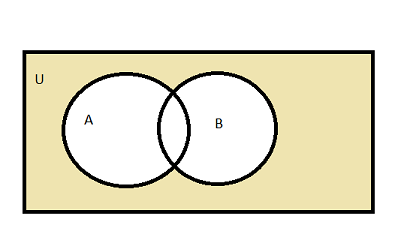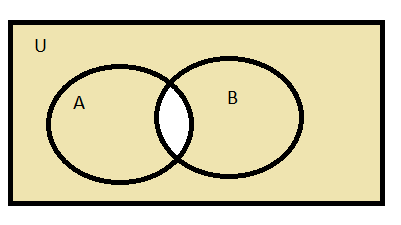问题1.令U = { 1,2,3,4,5,6,7,8,9},A = {1,2,3,4},B = {2,4,6,8}并且C = {3,4,5,6}。找:
(a)A’
解决方案:
We know that this is the complement of set A i.e, it is the subset of U.
So, A’ = {5, 6, 7, 8, 9}
(b)B’
解决方案:
We know that this is the complement of set B i.e, it is the subset of U.
So, B’ = {1, 3, 5, 7, 9}
(c)(A∪C)’
解决方案:
This is the complement of union of set A and set C i.e, U – (A∪ C)
So, A∪ C = {1, 2, 3, 4, 5, 6}
=> U – (A ∪ C)
So, (A∪ C)’ = {7, 8, 9}
(d)(A∪B)’
解决方案:
This is complement of union of set A and set B i.e, U- (A∪B)
So, A∪ B = {1, 2, 3, 4, 6, 8}
=> U – (A ∪ B)
So, (A ∪ B)’ = {5, 7, 9}
(e)(A’)’
解决方案:
This is the complement of set A i.e, (A’)’ = A
So, (A’)’ = {1, 2, 3, 4}
(f)(B – C)’
解决方案:
(B – C) = elements in B but not in C
(B – C) = {2, 8}
=> U – (B – C)
So, (B – C)’ = {1, 3, 4, 5, 6, 7, 9}
问题2。如果U = {a,b,c,d,e,f,g,h},请找到以下几组的补集:
(a)A = {a,b,c}
解决方案:
Complement of set A = A’
A’ = U – A
A’ = {a, b, c, d, e, f, g, h} – {a, b, c}
A’ = {d, e, f, g, h}
(b)B = {d,e,f,g}
解决方案:
Complement of set B = B’
B’ = U – B
B’ = {a, b, c, d, e, f, g, h} – {d, e, f, g}
B’ = {a, b, c, h}
(c)C = {a,c,e,g}
解决方案:
Complement of set C = C’
C’ = U – C
C’ = {a, b, c, d, e, f, g, h} – {a, c, e, g}
C’ = {b, d, f, h}
(d)D = {f,g,h,a}
解决方案:
Complement of set D = D’
D’ = U – D
D’ = {a, b, c, d, e, f, g, h} – {f, g, h, a}
D’ = {b, c, d, e}
问题3.以自然数集作为通用集,写下以下集合的补数:
U = N: set of natural numbers
(a) {x : x is an even natural number}
=> {x : x is an odd natural number}
(b) {x : x is an odd natural number}
=>{x : x is an even natural number}
(c) {x : x is a positive multiple of 3}
=>{x : x∈N and x is not a multiple of 3}
(d) {x : x is a prime number}
=> {x : x is a positive composite number and x=1}
(e) {x : x is a natural number divisible by 3 and 5}
=> {x : x is a natural number that is not divisble by 3 or 5}
(f) {x : x is a perfect square}
=> {x : x∈N and x is not perfect square}
(g) {x : x is a perfect cube}
=> {x : x∈N and x is not perfect cube}
(h) {x : x + 5 = 8}
=> {x : x∈N and x≠3}
(i) {x : 2x + 5 = 9}
=> {x : x∈N and x≠2}
(j) {x : x ≥ 7}
=> {x : x∈N and x<7}
(k) {x : x ∈ N and 2x + 1 > 10}
=> {x : x∈N and x≤ 9/2}
问题4.如果U = {1,2,3,4,5,6,7,8,9},A = {2,4,6,8},B = {2,3,5,7}。验证
(a) (A∪B)’= A’∩B’
解决方案:
=> (A ∪ B)’= U – (A∪B)
=> {1, 2, 3, 4, 5, 6, 7, 8, 9} – {2, 3, 4, 5, 6, 7, 8}
=> (A∪B)’ = {1, 9}
A’ ∩ B’ = (U – A) ∩ (U – B)
=> {1, 3, 5, 7, 9} ∩ {1, 4, 6, 8, 9}
=> A’ ∩ B’ = {1, 9}
Hence, Verified!!! (A∪ B)’ = A’ ∩ B’
(b)(A∩B)’= A’∪B’
=> (A ∩ B)’ = U – (A ∩ B)
=> {1, 2, 3, 4, 5, 6, 7, 8, 9} – {2}
=> (A ∩ B)′ = {1, 3, 4, 5, 6, 7, 8, 9}
A’ ∪ B’= (U – A) ∪ (U – B)
=> {1, 3, 5, 7, 9} ∪ {1, 4, 6, 8, 9}
=> A′ ∪ B′ = {1, 3, 4, 5, 6, 7, 8, 9}
Hence, Verified!!! (A ∩ B)′ = A′ ∪ B′
问题5.为以下各项绘制适当的维恩图:
(a)(A∪B)’=

(b)A’∩B’

(c)(A∩B)’

(d)A’∪B’

问题6.令U为平面中所有三角形的集合。如果A为所有至少具有一个不同于60°角的三角形的集合,那么A’是什么?
解决方案:
U = set of all triangles in plane
A = set of all triangles with at least one angle different from 60°
A’ = set of all triangles with no angle different from 60° i.e, set of all triangles with all angles 60°
A’ is the set of all equilateral triangle.
问题7.填空以使以下各项成为真实陈述:
解决方案:
(a) A ∪ A′ = U
(b) ∅′ ∩ A = A
(c) A ∩ A′ = ∅
(d) U′ ∩ A =.∅